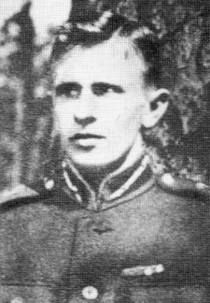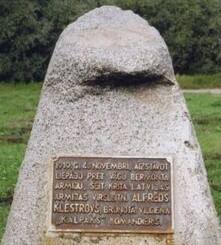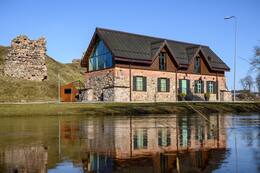Reasons for awarding the award to Commander of the Armoured Train A.Klestrov

After successfully repelling an enemy attack, the commander of the armed train A.Klestrov falls and Colonel Danker issued the grounds for the award
"In November 1919, Lieutenant Commander of the armed train "KOLPAKS", Lieutenant KĻESTROV, skillfully led the train against the Germans.
The Germans were close to Liepaja and kept up a steady fire on the station and railway line where the "KOLPAKS" was based. On November 3, after midday, the Germans came on the attack on the forts, launching their general assault on Liepaja. The armoured train under the skilful leadership of Lieutenant Commander KLESTROV, despite the enemy's incessant artillery and machine-gun fire, went on the counter-attack. When the train had reached the enemy's chains so that it was impossible to operate the cannon, Oberleutnant KLESTROV and his command, supported by machine-gun fire from the train, went to meet the enemy in a bayonet fight, which the enemy could not withstand and began to retreat. At the successful pursuit of the enemy, Ober-Lieutenant KLESTROV fell from an enemy bullet."
Klestrov was awarded the Third Class of the Order of the Order of the Knights of the Laplace in 1922.
1935. g. A memorial plaque was erected at the place of K.'s death at the junction of Liepāja railway and Liepāja-Grobiņa highway.
Related objects
Monument to Latvian Army Lieutenant Alfreds Klestrovs, battle site of the armoured train "Kalpaks"
Lieutenant Commander of the Armoured Train Lieutenant Alfred Klestrov , born 8 March 1897 in Liepaja. Graduated from Liepāja City School, then from the surveyors' school in Riga.
Conscripted into the Russian Army during World War I, graduated from the Battalion School in Moscow. Served on the Romanian front, fought in Ukraine. When Ukraine was occupied by German troops, he returned to Riga.
The Order was awarded in 1922
Conscripted into the Latvian Army in the spring of 1919, served in the additional battalion of the 3rd Latgale Division. In October 1919 he was assigned to the armoured train "Kalpaks" as a commander.
On 4 November 1919, when the Germans attacked Liepāja, the commander of the armoured train "Kalpaks", Lieutenant Alfred Klyestrov, under heavy artillery and machine-gun fire, counter-attacked and got behind enemy lines with the armoured train. Unable to open cannon fire, he led his team in a bayonet fight and dispersed the enemy, thus contributing to the withdrawal of the Bermontese attack, but he himself fell in this battle to a bullet from German soldiers who had entrenched themselves at home and remained behind the Latvian army soldiers.
In 1935, a memorial plaque was erected at the place of death of Lieutenant Alfred Klestrovs, commander of the armoured train "Kalpaks", at the junction of the Liepāja railway and Liepāja-Grobiņa highway.
Free State Treasure House
The Treasure House of the Free State is located next to the Rēzekne Castle ruins.
The unique exhibition includes hundreds of different historical testimonies from Latvian and foreign private collections, covering the period from 1918 to 1940, revealing the events in the history of Latgale and Rēzekne. It presents the history of military and civilian awards of the First Free State of Latvia, as well as various organisations related to the activities of state and civic organisations in the period from the Latvian War of Independence to World War II.
The collection of military and civilian awards and insignia of the Latvian Free State on display here is the largest one in Latvia.
The Changing Exhibition Hall is situated on the second floor, where a new exhibition is held at least once per year. To date, visitors have had the opportunity to see a unique collection of porcelain objects, luxury clocks from France and paintings depicting various landscapes of Latgale.






